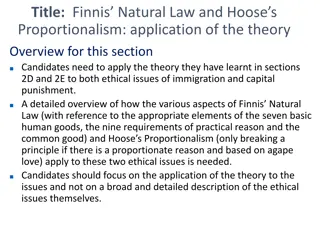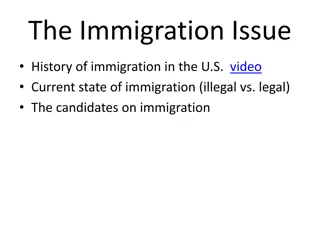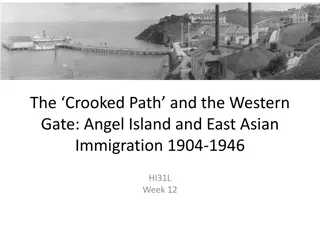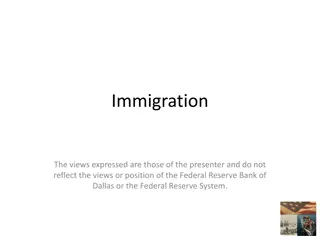Comprehensive Overview of Immigration and Economic Effects in the U.S.
This content delves into various aspects of immigration, including the economic effects and debates surrounding illegal immigration. It also includes a review of income inequality models and presents three short videos discussing the costs, benefits, and responses to immigration issues.
Download Presentation

Please find below an Image/Link to download the presentation.
The content on the website is provided AS IS for your information and personal use only. It may not be sold, licensed, or shared on other websites without obtaining consent from the author.If you encounter any issues during the download, it is possible that the publisher has removed the file from their server.
You are allowed to download the files provided on this website for personal or commercial use, subject to the condition that they are used lawfully. All files are the property of their respective owners.
The content on the website is provided AS IS for your information and personal use only. It may not be sold, licensed, or shared on other websites without obtaining consent from the author.
E N D
Presentation Transcript
22a Immigration This web quiz may appear as two pages on tablets and laptops. I recommend that you view it as one page by clicking on the open book icon at the bottom of the page.
22a - Immigration U.S. Immigration The Numbers Economic Effects of Immigration (Model) The Illegal Immigration Debate (Model)
Review: Lesson 20a Income Inequality YP 67 #9 - The Case for Equality Model of Income Distribution: The President Trump Example YP 71 # 13 - The Occupational Segregation Model of Discrimination YP 72-73 - As Our Jobs Are Automated, Some Say We'll Need A Guaranteed Basic Income 22a - Immigration
22a - Immigration U.S. Immigration The Numbers Economic Effects of Immigration (Model) The Illegal Immigration Debate (Model)
Three Short Videos Costs, Benefits and How Best to Respond - Professor Richard D Wolff. begin at 3:35 CNN Report on the economics of immigration (2:24) "Three Ways To Totally Transform U.S. Immigration Policy" NPR, Planet Money, Feb. 21, 2013 Audio only 1. The Best And The Brightest 2. The Highest Bidder 3. Let 'Em In 22a - Immigration
Three Short Videos (1) Costs, Benefits and How Best to Respond - Professor Richard D Wolff. begin at 3:35 22a - Immigration
Three Short Videos (2) CNN Report on the economics of immigration (2:24) 22a - Immigration
Three Short Videos (2) CNN Report on the economics of immigration (2:24) 22a - Immigration
Three Short Videos (3) "Three Ways To Totally Transform U.S. Immigration Policy" NPR, Planet Money, Feb. 21, 2013 Audio only 1. The Best And The Brightest 2. The Highest Bidder 3. Let 'Em In 22a - Immigration
Three Short Videos (3) "Three Ways To Totally Transform U.S. Immigration Policy" NPR, Planet Money, Feb. 21, 2013 Audio only 1. The Best And The Brightest 2. The Highest Bidder 3. Let 'Em In 22a - Immigration
Introduction Immigration is another labor issue that has become an important political topic. We will first study some historical data on U.S. immigration, then we will look at two immigration models: 1. a simple immigration model showing the "Impact on Wage Rates, Efficiency, and Output", and 2. a model showing the impact of illegal workers in a low wage labor market The YELLOW PAGES, the LESSONS webpage, and the MICWEBAPP have one page summaries of each of these models. You should find them and study them. 22a - Immigration
Something Interesting Why Study This? Read this short news article from 2013: http://www.nytimes.com/2013/02/17/magazine/do-illegal- immigrants-actually-hurt-the-us-economy.html From the eighth paragraph of the above website: Nearly all economists, of all political persuasions, agree that immigrants those here legally or not benefit the overall economy. That is not controversial, Heidi Shierholz, an economist at the Economic Policy Institute, told me. Shierholz also said that there is a consensus that, on average, the incomes of families in this country are increased by a small, but clearly positive amount, because of immigration." 22a - Immigration
22a - Immigration Must Know / Outcomes: Understand the historical pattern of legal and illegal immigration the United States. Understand what motivates an individual to migrate. List the factors influencing the decision to migrate. Understand the potential impact immigration can have on wage rates, efficiency, and output. MODEL: Impact on Wage Rates, Efficiency, and Output" YP 102 Identify potential complications with the traditional model of immigration: Remittances, Backflows, Full-Employment or Unemployment, and Complements and Substitutes. Understand the effect immigration to the United States has on Federal, State, and Local governments' fiscal position. Understand the illegal immigration debate in the context of job "crowding-out. MODEL: Impact of Illegal Workers in a Low Wage Labor Market YP 103 Explain the potential price effects that illegal immigration can have on an economy. Understand the concept of 'optimal' immigration.
22a - Immigration KEY TERMS: economic immigrants, legal immigrants, illegal immigrants, human capital, beaten paths, backflows, efficiency gains from migration, brain drain, remittances, complementary resource, substitute resource, fiscal impacts
22a - Immigration U.S. Immigration The Numbers Economic Effects of Immigration (Model) The Illegal Immigration Debate (Model)
U.S. Legal Immigrants Which programs? - 2009 22a - Immigration
# Legal Immigrants into the United States TOP 10 COUNTRIES 2009 22a - Immigration
Legal Immigrants in the United States - 2017 (% total) 22a - Immigration
Foreign-born workers represented 16.1 percent of the U.S. labor force in 2012.
U.S. Immigration Numbers SUMMARY About 1 million additional legal immigrants per year Over half come as family reunification immigrants Top source countries: Mexico, China, India, Philippines (about 20% of total) About 13% of U.S. population (near historic high) About 35 million legal and 10 million unauthorized About 16% of U.S. Labor Force 22a - Immigration
22a - Immigration U.S. Immigration The Numbers Economic Effects of Immigration (Model) The Illegal Immigration Debate (Model)
Simple Immigration Model YP 81-82 Assumptions: (1) The demand for labor in Alphania and Betania are as shown by DA and DB, respectively; (2) Alphania's native labor force is F and that of Betania is g; (3) Wage L in Alphania is equal to Wage m in Betania; and (4) Full employment exists in both countries (5) Product and labor markets are competitive
22a Simple Immigration Model Therefore: Total Product = area under MP In a competitive product market: Dlabor = MRP = VMP = P x MP So the Dlabor is a measure of the MP, and the area under the Dlabor is a measure of Total Product (TP)
Simple Immigration Model YP 82 #5 Alphania's domestic labor force is F and that of Betania is g. Wage L = wage m 1. As a result of migration: 1. World output will increase by mljh minus MLJH 2. Betania s output will increase, Alphania s decrease, but world output will stay the same 3. World output will increase by gjhf minus GJHF 4. World output will decrease by gjhf minus GJHF
Simple Immigration Model YP 82 #5 Alphania's domestic labor force is F and that of Betania is g. 1. As a result of migration: 1. World output will increase by mljh minus MLJH 2. Betania s output will increase, Alphania s decrease, but world output will stay the same 3. World output will increase by gjhf minus GJHF 4. World output will decrease by gjhf minus GJHF
As a result of migration: wages up in source country wages down in destination country total output increases 22a - Immigration
2. Remittances from migrants could: [Alphania's native labor force is F and that of Batania is g.] YP 82 #6 1. Decrease the economic loss in Betania 2. Increase the economic gain in Betania 3. Decrease the economic loss in Alphania 4. Increase the economic gain in Alphania
2. Remittances from migrants could: [Alphania's native labor force is F and that of Batania is g.] YP 82 #6 1. Decrease the economic loss in Betania 2. Increase the economic gain in Betania 3. Decrease the economic loss in Alphania 4. Increase the economic gain in Alphania
3. If there initially was unemployment in Alphania instead of the assumed full employment, then: YP 82 #7 1. Betania s loss of output would have been greater 2. Betania s loss of output would have been less 3. Alphania s loss of output would have been less 4. Alphania s loss of output would have been greater
3. If there initially was unemployment in Alphania instead of the assumed full employment, then: YP 82 #7 1. Betania s loss of output would have been greater 2. Betania s loss of output would have been less 3. Alphania s loss of output would have been less 4. Alphania s loss of output would have been greater
4. Assume that the pre-migration labor force in Country A is 100 and that it is 150 in country B. The migration of labor will: 1. Increase wages in A and decrease wages in B 2. Increase wages in B and decrease wages in A 3. Increase wages in both 4. decrease wages in both
4. Assume that the pre-migration labor force in Country A is 100 and that it is 150 in country B. The migration of labor will: 1. Increase wages in A and decrease wages in B 2. Increase wages in B and decrease wages in A 3. Increase wages in both 4. decrease wages in both
5. Assume that the pre-migration labor force in Country A is 100 and 150 in country B and 20 million migrate from A to B. After immigration output in A will: 1. Decrease by $ 50 2. Decrease by $ 150 3. increase by $ 50 4. increase by $ 150
5. Assume that the pre-migration labor force in Country A is 100 and 150 in country B and 20 million migrate from A to B. After immigration output in A will: 1. Decrease by $ 50 2. Decrease by $ 150 3. increase by $ 50 4. increase by $ 150
Loss = (20x5) + (20x5) = $150 = abcd + bec = aecd
6. Assume that the pre-migration labor force in Country A is 100 and that it is 150 in country B. After immigration output in B will: 1. increase by $ 50 2. Increase by $ 250 3. Decrease by $ 50 4. Decrease by $ 250
6. Assume that the pre-migration labor force in Country A is 100 and that it is 150 in country B. After immigration output in B will: 1. increase by $ 50 2. Increase by $ 250 3. Decrease by $ 50 4. Decrease by $ 250
GAIN = (10x20) + (20x5) = $250 = ABCD + BEC = AECD
Simple Immigration Model Effects: YP 77 and 102 Wages increase in source country Wages decrease in destination country Total output increases (the increase in output in the destination country is greater than the loss of output in the source country) Complications (BUT): Costs of migration have been ignored would reduce migration Remittances and backflows reduce loss in source country and reduce gain in destination country Complementary resources vs. substitute resources job GAINS in complementary occupations in destination country therefore even greater gain in output Expansion of capital in destination country therefore even greater gain in output We assumed full employment if there was unemployment in source country then smaller loss of output
SUMMARY - Simple Immigration Model All economists agree that U.S. immigration increases U.S. domestic output and income and that highly educated immigrants and successful entrepreneurs add to the vitality of American enterprise. But in light of the complications just discussed, no single generalization is possible as to the impact of immigration on the wages of native-born U.S. workers. The best evidence indicates that immigration reduces the wages of native-born workers who have low educations, and also may reduce the salaries of some highly trained native- born workers. The overall effect of immigration on the average American wage is much less clear. Scholarly estimates on that effect range from minus 3 percent to plus 2 percent.
22a - Immigration U.S. Immigration The Numbers Economic Effects of Immigration (Model) The Illegal Immigration Debate (Model)
Illegal Immigration Model YP 84 Assumptions: 1) Employers in this market are willing and able to ignore minimum wage laws; 2) Sd represents the supply of domestically-born (and legal immigrant) workers; 3) St represents the total supply of workers in this labor market (Sd plus illegal immigrants); and 4) Unless otherwise stated, illegal immigration is not effectively blocked by the government.
Illegal Immigration Model 7. How many domestically-born workers will be hired at equilibrium? (YP 84 #2) 1. 200,000 2. 250,000 3. 350,000 4. 450,000
Illegal Immigration Model 7. How many domestically-born workers will be hired at equilibrium? (YP 84 #2) 1. 200,000 2. 250,000 3. 350,000 4. 450,000
Total Employment = 450 = 250 domestic + 200 illegal (450 250)
8. If initially the govt cannot stop illegal immigration, but then finds a way to block it, then ____ domestic workers gain jobs and ____ immigrants lose jobs. (YP 85 #5) 1. 100,000 gain jobs, 200,000 lose 2. 200,000 gain jobs, 200,000 lose 3. 100,000 gain jobs, 250,000 lose 4. 100,000 gain jobs, 150,000 lose























